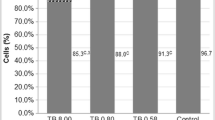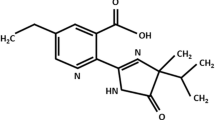Abstract
Although arsenic trioxide (ATO) has been the subject of toxicological research, in vitro cytotoxicity and genotoxicity studies using relevant cell models and uniform methodology are not well elucidated. Hence, the aim of the present study was to evaluate the cytotoxicity and genotoxicity induced by ATO in a human leukemia (HL-60) cell line using the MTT [3-(4, 5-dimethylthiazol-2-yl)-2,5-diphenyltetrazolium bromide] and alkaline single cell gel electrophoresis (Comet) assays, respectively. HL-60 cells were treated with different doses of ATO for 24 h prior to cytogenetic assessment. Data obtained from the MTT assay indicated that ATO significantly (P < 0.05) reduced the viability of HL-60 cells in a dose-dependent manner, showing a LD50 value of 6.4 ± 0.6 μg/mL. Data generated from the comet assay also indicated a significant dose-dependent increase in DNA damage in HL-60 cells associated with ATO exposure. We observed a significant increase (P < 0.05) in comet tail-length, tail arm and tail moment, as well as in percentages of DNA cleavage at all doses tested, showing an evidence of ATO-induced genotoxic damage in HL-60 cells. This study confirms that the comet assay is a sensitive and effective method to detect DNA damage caused by heavy metals like arsenic. Taken together, our findings suggest that ATO exposure significantly (P < 0.05) reduces cellular viability and induces DNA damage in HL-60 cells as assessed by MTT and alkaline single cell gel electrophoresis assays, respectively.





Similar content being viewed by others
References
NRC (1999) Arsenic in drinking water. U.S. National Research Council, National Academy Press. Washington, DC
IPCS (2001) Arsenic and arsenic compounds. World Health Organization, International Programme on Chemical Safety (Environmental Health Criteria 224). Geneva
Chen GQ, Zhu J, Shi XG, Ni HJ, Zhong HJ, Si GY, Jin XL, Tang W, Li XS, Xong SM, Shen ZX, Sun GL, Ma J, Zhang P, Zhang TD, Gazin C, Naoe T, Chen ST, Wang ZY, Chen Z (1996) In vitro studies on cellular and molecular mechanisms of arsenic trioxide (As2O3) in the treatment of acute promyelocytic leukemia: arsenic trioxide induces NB 4 cell apoptosis with down-regulation of bcl-2 expression and modulation of PML-RAR α/PML proteins. Blood 88:1052–1061
Rousselot P, Labaume S, Marolleau JP, Larghero J, Noguera MK, Brouet JC, ermand JP (1999) Arsenic trioxide and melarsoprol induce apoptosis in plasma cell lines and in plasma cells from myeloma patients. Cancer Res 59:1041–1048
Zhang K, Ohnishi K, Shigeno, Fujisawa S, Naito K, Nakamura S, Takeshita K, akeshita A, Ohno R (1998) The induction of apoptosis and cell cycle arrest by arsenic trioxide in lymphoid neoplasms. Leukemia 12:1383–1391
Huang SY, Chan CS, Tang JL, Tien HF, Kuo TL, Huang SF, Yoa YT, Chou WC, Chung CY, Wang CH, Shen MC, Chen YC (1998) Acute and chronic poisoning associated with treatment of acute promyelocytic leukemia. Br J Haematol 103:1092–1095
Tchounwou PB, Centeno JA, Patlolla AK (2004) Arsenic toxicity, mutagenesis and carcinogenesis: a health risk assessment approach. Mol Cell Biochem 225:47–55
Wu MM, Kuo TL, Hwang YH, Chen CJ (1989) Dose-response relation between arsenic concentration in well water and mortality from cancers and vascular diseases. Am J Epidemiol 130:1123–1132
IARC (1987) Monographs on the Evaluation of Carcinogenic Risks of Chemicals to Humans. Supplement F. Overall Evaluation of Carcinogenicity. International Agency for Research on Cancer. World Health Organization. Lyon, France, pp 29–57
Aschengran A, Zierler S, Cohen A (1989) Quality of community drinking water and the occurrence of spontaneous abortion. Arch Environ Health 44:283–290
ATSDR (1993) Toxicological Profile for Arsenic TP-92/09. Agency for Toxic Substancesand Disease Registry. Center for Disease Control, Atlanta, GA
Li JH, Rossman TC (1989) Inhibition of DNA ligase activity by arsenite: a possible mechanism of its comutagenesis. Mol Toxicol 2:1–9
Schwerdtle T, Walter I, Mackiw I, Hartwig A (2003) Induction of oxidative DNA damage by arsenite and its trivalent and pentavalent methylated metabolites in cultured human cells and isolated DNA. Carcinogenesis 24:967–974
Kitchin KT, Ahmad S (2003) Oxidative stress as a possible mode of action for arsenic carcinogenesis. Toxicol Lett 137:3–13
Kitchin KT (2001) Recent advances in carcinogenesis: modes of action, animal model systems, and methylated arsenic metabolites. Toxicol Appl Pharmacol 172:249–261
Anderson D, Yu TW, Phillips BJ, Schemezer P (1994) The effect of various antioxidants and other modifying agents on oxygen-radical-generated DNA damage in human lymphocytes in the Comet assay. Mutation Res 307:261–271
Tchounwou PB, Wilson B, Schneider J, Ishaque A (2000) Cytogenic assessment of arsenic trioxide toxicity in the Mutatox, Ames II and CAT-Tox assays. Metal Ions Biol Med 6:89–91
Patlolla A, Tchounwou PB (2005) Cytogenetic evaluation of arsenic trioxide toxicity in Sprague-Dawley rats. Mutation Res 587:126–133
Barrett JC, Lamb PW, Wang TC, Lee TC (1989) Mechanisms of arsenic-induced cell transformation. Biol Trace Elem Res 21:421–429
Hartmann A, Peit G (1994) Comparative investigations of the genotoxic effects of metals in the single cell gel assay and the sister chromatid exchange test. Environ Mol Mutagen 23:299–305
Saleha Banu B, Danadevi K, Kaiser Jamil, Ahuja YR, Visweswara Rao K, Ishap M (2001) In vivo genotoxic effect of arsenic trioxide in mice using comet assay. Toxicol 162:171–177
Tchounwou PB, Wilson BA, Abdelgnani AA, Ishaque AB, Patlolla AK (2002) Differential cytotoxicity and gene expression in human liver carcinoma (HepG2) cells exposed to arsenic trioxide and monosodium acid methanearsonate (MSMA). Int J Mol Sci 3:1117–1132
Tchounwou PB, Yedjou CG, Dorsey WC (2003) Arsenic trioxide––induced transcriptional activation and expression of stress genes in human liver carcinoma cells (HepG2). Cell Mol Biol 49:1071–1079
Freshney RI (1983) Culture of animal cells. A manual of basic techniques. University Library, Alan Liss Inc
Paul J (1975) Cell and Tissue Culture. CSL, Churchill Livingstone
Mosmann T (1983) Rapid colorimetric assay for cellular growth and survival: applications to proliferation and cytotoxicity assays, J Immunol Methods 65:55–63
Tchounwou PB, Yedjou CG, Foxx D, Ishaque A, Shen E (2004) Lead––induced cytotoxicity and transcriptional activation of stress genes in human liver carcinoma cells. Mol Cell Biochem 255:161–170
Todd MD, Lee MJ, Williams JL, Nalenzny JL, Gee P, Benjamin MB, Farr SB (1995) The CAT-Tox assay: sensitive and specific measure of stress induced transcription in transformed human liver cells. Fund Appl Toxicol 28:118–128
Jing Y, Dai J, Charmers-Redman RM, Tatto WG, Waxman S (1999) Arsenic trioxide selectively induces acute promyelocytic leukemia cell apoptosis via a hydrogen peroxide-dependent pathway. Blood 94:102–2111
Jai P, Chen G, Huang X, Cai X, Yang J, Wang L, Zhou Y, Shen Y, Zhou L, Yu Y, Chen S, Zhang X, Wang Z (1999) Arsenic trioxide induces multiple myeloma cell apoptosis via disruption of mitochondrial transmembrane potentials and activation of caspace-3. Chin Med J 114:19–24
Soignet SL, Frankel SR, Douer D, Tallman MS, Kantarjian H, Calleja E, Stone RM, Kalaycio M, Scheinberg DA, Steinherz P, Sievers EL, Coutré S, Dahlberg S, Ellison R, Warrell RP Jr (2001) United States multicenter study of arsenic trioxide in relapsed acute promyelocytic leukemia. J Clin Oncol 19:3852–3860
Ostling O, Johanson KJ (1984) Microelectrophoretic study of radiation-induced DNA damages in individual mammalian cells. Biochem Biophys Res Commun 123:291–298
Rojas E, Lopez MC, Valverde M (1999) Single gel electophoresis assay: methodology and application. J Chromatogr 722:225–254
Jaiswal M, Anuradha G, Rajeswari N, Raj KN, Balakrishna N, Rao KV, Prasand IS, Jain SN, Ahuja YR (1994) Comet assay on cervical epithelial cells and leucocytes of patients with precancerous and cancerous lesions of the cervix. Med Sci Res 22:879–881
Acknowledgments
This research was financially supported by a grant from the National Institutes of Health (Grant No. 1G12RR13459), through the RCMI-Center for Environmental Health at Jackson State University. The authors thank Dr. Abdul Mohamed, dean emeritus of College of Science, Engineering & Technology at Jackson State University, for his technical support of this research. This paper was presented at the 2nd International Symposium on Recent Advances in Environmental Health Research (September 18–21, 2005) at the Regency hotel in Jackson, MS, USA.
Author information
Authors and Affiliations
Corresponding author
Rights and permissions
About this article
Cite this article
Yedjou, C.G., Tchounwou, P.B. In-vitro cytotoxic and genotoxic effects of arsenic trioxide on human leukemia (HL-60) cells using the MTT and alkaline single cell gel electrophoresis (Comet) assays. Mol Cell Biochem 301, 123–130 (2007). https://doi.org/10.1007/s11010-006-9403-4
Received:
Accepted:
Published:
Issue Date:
DOI: https://doi.org/10.1007/s11010-006-9403-4




